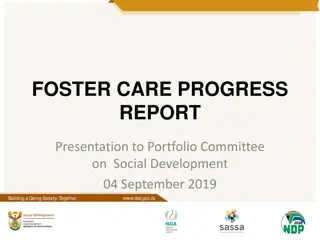Understanding Wash Resistance Studies in ITN Fabric Assessment
Wash resistance studies play a crucial role in assessing the durability and performance of insecticide-treated net (ITN) fabrics. These studies involve determining wash intervals, conducting artificial ageing assessments, and selecting appropriate mosquito species for bioassays. The purpose of wash resistance studies is to investigate how ITN fabric performs over multiple wash cycles, measuring the rate of loss of active ingredients through chemical analysis and bioassays. The outcomes provide insights into the longevity and efficacy of ITN fabrics for vector control programs.
- Wash resistance studies
- ITN fabric assessment
- Insecticide-treated net
- Mosquito species selection
- Bioassays
Uploaded on Dec 06, 2024 | 0 Views
Download Presentation

Please find below an Image/Link to download the presentation.
The content on the website is provided AS IS for your information and personal use only. It may not be sold, licensed, or shared on other websites without obtaining consent from the author. Download presentation by click this link. If you encounter any issues during the download, it is possible that the publisher has removed the file from their server.
E N D
Presentation Transcript
Wash resistance studies and determining a wash interval for use in Wash resistance studies and determining a wash interval for use in artificial ageing studies artificial ageing studies Mosquito species and strain selection for use in bioassays Mosquito species and strain selection for use in bioassays GM Foster ITN guideline consultation session Geneva, 18-20 October, 2022
Wash resistance studies and determining a wash interval for use in Wash resistance studies and determining a wash interval for use in artificial ageing studies artificial ageing studies
Wash resistance studies and determining a wash interval for use in artificial ageing (1) Historically (in the existing guidelines), the wash interval for artificial ageing studies was based on the regeneration time determined during the wash regeneration study Does this approach underestimate the loss of AI per wash? If the wash regeneration time as determined in the wash regeneration study, i.e., the time taken to reestablish biological insecticidal activity, is used as the wash interval in an artificial ageing study, will the results of that study suit the purpose of the wash resistance study as it pertains to a prequalification assessment? What is the purpose of a wash resistance study?
Wash resistance studies and determining a wash interval for use in artificial ageing (2) What is the purpose of a wash resistance study? For the purpose of the prequalification assessment, wash resistance studies are conducted to investigate how an ITN fabric performs through a series of washes by means of: chemical analysis to determine the rate of loss for AI(s), and bioassay(s) to investigate the consistency of biological activity of the material s surface The series of washes is intended to simulate the intended useful life of the ITN during which there is loss of AI(s) from each wash and re-establishment of surface concentration/s post-wash.
Wash resistance studies and determining a wash interval for use in artificial ageing (3) What does a wash resistance study tell us about the fabric(s) used in the construction of ITNs? The wash resistance study is intended to measure the rate at which the AI(s) in the reservoir (bound in coating or within the yarn) is depleted through the series of washes by measuring the chemical content. The loss of AI(s) per wash is influenced by the wash interval, i.e., the number of days between washes Measurements of AI content in the fabric and washing rinsate can be used to estimate the reservoir and surface concentrations through the series of washes. Bioassay(s) are used to measure the biological activity of the material s surface at particular points in the series of washes in order to investigate the continuity of the induced effect on the organism(s) used for the bioassay(s) the number of days between washing and conducting the bioassay can impact results
Wash resistance studies and determining a wash interval for use in artificial ageing (4) Requirement for submission of wash resistance studies A wash resistance study/ies are conducted for each fabric used within the construction of an ITN. The specific formulation and manufacturing process for the fabric can significantly influence the behaviors of the treated fabric, especially the rate at which active ingredient(s) move from the reservoir to the surface and are thereby lost by means of washing. Studies from at least 2 independent testing facilities should be generated. Wash resistance studies must be GLP compliant.
Mosquito species and strain selection for use in Mosquito species and strain selection for use in bioassays bioassays
Mosquito species and strain selection for use in bioassays (1) Mosquito species and strain selection for use in bioassays (1) What is the purpose of a bioassay as it pertains to a prequalification assessment? Bioassays are conducted during laboratory studies, i.e., wash regeneration studies and wash resistance studies, and supplemental to semi-field studies: Module 3 characterize fabric Module 5 semi-field trials are used to estimate efficacy the supplementary bioassays performed alongside semi-field trials characterize the fabric used in the trials at different points (before and after washing, before and after the trial) such that the consistency/nature of the fabric during the efficacy trial is demonstrated. For both Module 3 and Module 5, the purpose of bioassays is to characterize the ITN fabric What are the considerations for choosing the most appropriate mosquito strains to characterize a fabric?
Mosquito species and strain selection for use in bioassays (2) Mosquito species and strain selection for use in bioassays (2) Mosquito species and strain selection is dependent on the intended use of the product and its mode of action The mosquito species chosen must be known vectors of the disease for which the product is intended to provide protection The mosquito strain characteristics must be indicative of the target population against which the product is intended to have an effect Mosquito strain characteristics: Target vector characteristics: Primary Secondary Definition of the product intended effect and primary and secondary target vector characteristics will inform the selection of mosquito strain/s
Mosquito species and strain selection for use in bioassays (3) Mosquito species and strain selection for use in bioassays (3) Inclusion of a variety of species/strains across the supporting information may be necessary to investigate, characterize and/or determine properties of a proposed ITN as well as demonstrate expectations of product performance across a range of target vectors. Susceptible mosquito strains: In this age of widespread pyrethroid resistance, the use of susceptible strains may not be informative regarding the ability of the product to induce the intended effect on the target mosquito population The inclusion of a susceptible strain of mosquitoes in applicable studies may be an important factor to support the establishment of a baseline dataset about the product. Pyrethroid resistant strains: Bioassays using pyrethroid resistant strains may be necessary to characterise the properties of the proposed ITN if the intended use includes inducing an effect in pyrethroid resistant mosquitoes Pyrethroid + synergist ITN metabolic resistance Diversity in mosquito strain selection may provide information about the breadth of effect of the product
Mosquito species and strain selection for use in bioassays (4) Mosquito species and strain selection for use in bioassays (4) The use of multiple mosquito strains to characterize fabrics: ITNs co-formulated with multiple AIs Monitoring of mosquito strains used in bioassays Mosquito strains used in bioassays should be characterised such that the target characteristics carried by the strain with respect to the expected effect of the product can be assessed Insecticide susceptibility/resistance status Insecticide resistance intensity Frequency of characterization Additional characteristics Limitations of using a bioassay for characterizing fabric Bioassays can only provide a snapshot of the insecticidal activity on the surface at the time of testing























